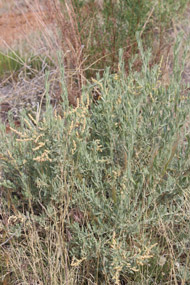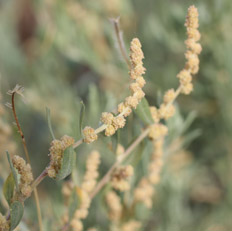 |
 |
Food:
"Like almost every common shrub in our area, saltbush has proven useful to native peoples past and present. Many years ago the nutritious seeds were ground and cooked and sometimes raw or were dried and mixed with other ingredients to form a flour for breads and cakes. Ashes of burned saltbush are used as leavening for breads, as a food coloring, and in the making of lye to soften the hulls of corn. All these uses are, incidentally, and effective way of making the niacin in the inner grain available, thus enhancing the amino acid content of potentially digestive proteins in corn. In societies that traditionally process maize with alkali in this way, there's little evidence of the dietary deficiency disease pellagra.
Many other uses of saltbush are known. The ashes of burned saltbush are still used in Hopi country to impart a greenish hue to the finely ground blue cornmeal of piki bread." (Dunmire and Tierney 130)
Medicine:
"At Zuni handfuls of blossoms (probably male) are crushed and mixed with a little water and used like a hand soap. This suggests that fourwing saltbush contains saponins. Crushed flowers, either dried or fresh, are also used topically for ant bites, and the roots of another species of saltbush, Atriplex argentea, are used for skin sores and rashes." (Dunmire and Tierney 131)
"At Tularosa, the green leaves are chewed with a pinch of salt, followed by a swallow of water, to relieve bad stomach pains." (Curtin 43)
Other Uses:
"Also, because of the ubiquity of the shrub, it's not surprising that saltbush has been used whole to calk or cover the roofs of above dwellings. The shape of the main stems has also suggested many uses as tools and kitchen utensils. Having many tines protruding from the central stalk, a peeled branch from a browsed shrub makes a good whisk for stirring large pots of cereal or cornmeal mush; uses of such an impromptu whisk has the dividend of imparting a mildly salty taste to the otherwise bland ingredients of a campfire meal.
The hard twig ends of saltbushes, tending to be spiny or pointed, were further shaped by carving and used for arrowheads, inserted into the hollow ends of reedgrass or other shaft material. This type of point was used for the swift or war arrow and was considered poisonous or infectious by the people of Isleta. Arrows with stone points were used for game." (Dunmire and Tierney 130)
"The Zuni attach prayer plumes to the bush in the belief that this action will bring forth the cottontail rabbits in large numbers." (Curtin 41)
Internet Resources